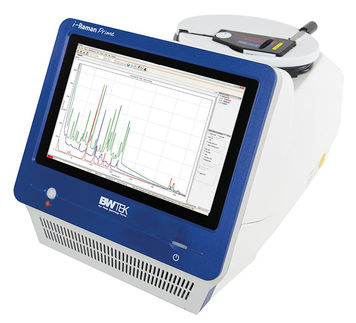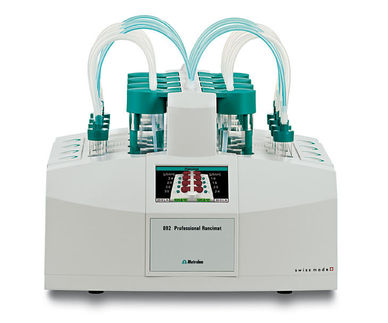In the field of neurochemistry, 5-HT receptors are receptors for the neurotransmitter and peripheral signal mediator serotonin, also known as 5-hydroxytryptamine or 5-HT.[1] 5-HT receptors are located on the cell membrane of nerve cells and other cell types including smooth muscle in animals, and mediate the effects of serotonin as the endogenous ligand and of a broad range of pharmaceutical and hallucinogenic drugs. All 5-HT receptors reduce cyclic adenosine monophosphate (cAMP). 5-HT receptors effect the release and activity of other neurotransmitters such as glutamate, dopamine and GABA. 5-HT2A receptors increase the activity of glutamate in many areas of the brain, while some other serotonin receptors have the effect of suppressing glutamate. Increased stimulation of 5-HT2A receptors seem to oppose the therapeutic actions of increased stimulation of other serotonin receptors in anti-depressant and anxiolytic treatments. [1]
Classification
With the exception of the 5-HT3 receptor, a ligand gated ion channel, all other 5-HT receptors are G protein coupled seven transmembrane (or heptahelical) receptors that activate an intracellular second messenger cascade.
Families
| Family | Type | Mechanism
|
| 5-HT1 | Gi/Go coupled | decreasing cellular levels of cAMP
|
| 5-HT2 | Gq/G11 coupled | increasing cellular levels of inositol trisphosphate (IP3) and diacylglycerol (DAG)
|
| 5-HT3 | ligand-gated Na+ and K+ cation channel | depolarizing plasma membrane
|
| 5-HT4 | Gs coupled | increasing cellular levels of cAMP
|
| 5-HT5A | G protein coupled; the primary coupling appears to be through Gi/o | inhibiting adenylate cyclase activity.[2]
|
| 5-HT7 | Gs coupled | increasing cellular levels of cAMP
|
Specific proteins/genes
Within these general classes of 5-HT receptors, a number of specific types have been characterized:
Summary of characterized 5-HT receptors, with selected high affinity agonist and antagonist ligands
| Receptor
| Gene
| Actions
| Agonists
| Antagonists
|
| 5-HT1A
| HTR1A
|
- CNS: neuronal inhibition, behavioural effects (sleep, feeding, thermoregulation, aggression, anxiety)
|
|
|
| 5-HT1B
| HTR1B
|
- CNS: presynaptic inhibition, behavioural effects
- vascular: pulmonary vasoconstriction
|
|
|
| 5-HT1D
| HTR1D
|
- CNS: locomotion, anxiety;
- vascular: cerebral vasoconstriction
|
- 5-(Nonyloxy)tryptamine,[3]
- sumatriptan
|
- methiothepin
- yohimbine
- metergoline
- ergotamine
|
| 5-HT1E
| HTR1E
|
|
|
|
| 5-HT1F
| HTR1F
|
|
|
| 5-HT2A
| HTR2A
|
- CNS: neuronal excitation, behavioural effects, learning, anxiety
- smooth muscle: contraction, vasoconstriction / vasodilatation
- platelets: aggregation
|
|
|
| 5-HT2B
| HTR2B
|
|
|
|
| 5-HT2C
| HTR2C
|
- CNS: anxiety, choroid plexus: cerebrospinal fluid (CSF) secretion
|
|
|
| 5-HT3
| HTR3A, HTR3B
|
- CNS, PNS: neuronal excitation, anxiety, emesis
|
|
|
| 5-HT4
| HTR4
|
- GIT, CNS: neuronal excitation, gastrointestinal motility, behavioural effects
|
|
|
| 5-HT5A
| HTR5A
|
- CNS (cortex, hippocampus, cerebellum): unknown
|
| unknown
|
| 5-HT6
| HTR6
|
|
| SB271046 [5]
|
| 5-HT7
| HTR7
|
- CNS, GIT, blood vessels: unknown
|
|
|
Note that there is no 5-HT1C receptor since, after the receptor was cloned and further characterized, it was found to have more in common with the 5-HT2 family of receptors and was redesignated as the 5-HT2C receptor.
Therapeutic modulation
Various drugs are used to modulate the 5-HT system including some antidepressants, anxiolytics, antiemetics,
antipsychotics and anti-migraine agents.
References
- ^ Hoyer D, Clarke DE, Fozard JR, Hartig PR, Martin GR, Mylecharane EJ, Saxena PR, Humphrey PP (1994). "International Union of Pharmacology classification of receptors for 5-hydroxytryptamine (Serotonin)". Pharmacol. Rev. 46 (2): 157–203. PMID 7938165.
- ^ a b Nelson DL (2004). "5-HT5 receptors". Current drug targets. CNS and neurological disorders 3 (1): 53–8. PMID 14965244.
- ^ Glennon RA, Hong SS, Dukat M, Teitler M, Davis K (1994). "5-(Nonyloxy)tryptamine: a novel high-affinity 5-HT1D beta serotonin receptor agonist". J. Med. Chem. 37 (18): 2828–30. doi:10.1021/jm00044a001. PMID 8071931.
- ^ Rang, H. P. (2003). Pharmacology. Edinburgh: Churchill Livingstone. ISBN 0-443-07145-4. Page 187
- ^ Target Schizophrenia - Possible future developments. Retrieved on 2007-07-06.
| Transmembrane receptor: G protein-coupled receptors |
|---|
| Class A: Rhodopsin like | Acetylcholine (M1, M2, M3, M4, M5) - Adrenergic (α1 (A, B, D), α2 (A, B, C), β1, β2, β3) - Adrenomedullin - Anaphylatoxin (C3a, C5a) - Angiotensin (1, 2) - Apelin - Bile acid - Bombesin (BRS3, GRPR, NMBR) - Bradykinin (B1, B2) - Cannabinoid (CB1, CB2) - Chemokine - Cholecystokinin (A, B) - Dopamine (D1, D2, D3, D4, D5) - Eicosanoid (CysLT (1, 2), LTB4 (1, 2), FPRL1, OXE, Prostaglandin ((DP (1, 2), EP (1, 2, 3, 4), PGF, Prostacyclin, Thromboxane) - EBI2 - Endothelin (A, B) - Estrogen - Formyl peptide (1, L1, L2) - Free fatty acid (1, 2, 3, 4) - FSH - Galanin (1, 2, 3) - Gonadotropin-releasing hormone (1, 2) - GPR (1, 3, 4, 6, 12, 15, 17, 18, 19, 20, 21, 22, 23, 25, 26, 27, 31, 32, 33, 34, 35, 37, 39, 42, 44, 45, 50, 52, 55, 61, 62, 63, 65, 68, 75, 77, 78, 79, 82, 83, 84, 85, 87, 88, 92, 101, 103, 119, 120, 132, 135, 139, 141, 142, 146, 148, 149, 150, 151, 152, 153, 160, 161, 162, 171, 172, 173, 174, 176, 182) - Ghrelin - Histamine (H1, H2, H3, H4) - Kisspeptin - Luteinizing hormone/choriogonadotropin - Lysophospholipid (1, 2, 3, 4, 5, 6, 7, 8) - MAS (1, 1L, D, E, F, G, X1, X2, X3, X4) - Melanocortin (1, 2, 3, 4, 5) - MCHR (1, 2) - Melatonin (1A, 1B)- Motilin - neuromedin (B, U (1, 2)) - Neuropeptide (B/W (1, 2), FF (1, 2), S, Y (1, 2, 4, 5)) - Neurotensin (1, 2) - Opioid (Delta, Kappa, Mu, Nociceptin, but not Sigma) - Olfactory - Opsin (3, 4, 5, 1LW, 1MW, 1SW, RGR, RRH) - Orexin (1, 2) - Oxytocin - Oxoglutarate - PAF - Prokineticin (1, 2) - Prolactin-releasing peptide - Protease-activated (1, 2, 3, 4) - Purinergics (Adenosine (A1, A2a, A2b, A3), P2Y, (1, 2, 4, 5, 6, 8, 9, 10, 11, 12, 13, 14)) - Relaxin (1, 2, 3, 4) - Somatostatin (1, 2, 3, 4, 5) - Serotonin, all but 5-HT3 (5-HT1 (A, B, D, E, F), 5-HT2 (A, B, C), 5-HT (4, 5A, 6, 7)) - SREB - Succinate - TAAR (1, 2, 3, 5, 6, 8, 9) - Tachykinin (1, 2, 3) - Thyrotropin - Thyrotropin-releasing hormone - Urotensin-II - Vasopressin (1A, 1B, 2) |
|---|
| Class B: Secretin like | Brain-specific angiogenesis inhibitor (1, 2, 3) - Cadherin (1, 2, 3) - Calcitonin - CD97 - Corticotropin-releasing hormone (1, 2) - EMR (1, 2, 3) - Glucagon (GR, GIPR, GLP1R, GLP2R) - Growth hormone releasing hormone - PACAPR1- GPR (56, 64, 97, 98, 110, 111, 112, 113, 114, 115, 116, 123, 124, 125, 126, 128, 133, 143, 144, 157) - Latrophilin (1, 2, 3, ELTD1) - Parathyroid hormone (1, 2) - Secretin - Vasoactive intestinal peptide (1, 2) |
|---|
| Class C: Metabotropic glutamate / pheromone | Calcium-sensing receptor - GABA B (1, 2) - Glutamate receptor (Metabotropic glutamate (1, 2, 3, 4, 5, 6, 7, 8)) - GPRC6A - GPR (156, 158, 179) - RAIG (1, 2, 3, 4) - Taste receptors (TAS1R (1, 2, 3) TAS2R (1, 3, 4, 5, 8, 9, 10, 12, 13, 14, 16, 38, 39, 40, 41, 43, 44, 45, 46, 47, 48, 49, 50)) |
|---|
| Frizzled / Smoothened | Frizzled (1, 2, 3, 4, 5, 6, 7, 8, 9, 10) - Smoothened |
|---|
| Ion channel, receptor: ligand-gated ion channels |
|---|
| Cys-loop receptors | 5-HT receptor (5-HT3 serotonin receptor (A)) - GABA receptor (GABA A (α1, α2, α3, α5, α6, β1, β2, β3, γ2, ε), GABA C (ρ1)) - Glycine receptor (α1) - Nicotinic acetylcholine receptor (α1, α2, α3, α4, α5, α7, β2, β3, β4, δ, ε, (α4)2(β2)3, (α7)5, Ganglion type, Muscle type) |
|---|
| Ionotropic glutamate receptors | AMPA (1, 2, 3, 4) - Kainate (1, 2) - NMDA (1, 2A, 2B, 2C, 2D) |
|---|
| ATP-gated channels | Purinergic receptors (P2X (1, 4, 5, 7)) |
|---|
|







